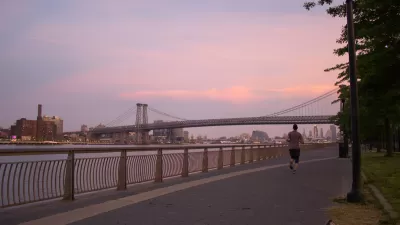As NYC struggles to cope with the damage from Superstorm Sandy, officials and experts are revisiting the possibility of building, at great cost, a protective barrier around its coast.
In the midst of the recent storm, a two-mile-long barrier system built in 1969 at the cost of $14.5 million, kept Stamford, CT protected from an estimated $25 million in damage to businesses and homes, reports Mireya Navarro. Stamford's mayor, Michael A. Pavia, said: "It was extremely effective in protecting areas that would have been flooded completely by this storm. It made all the difference in the world." If it worked in Stamford, can it work for New York?
"The technology of movable sea barriers, from Stamford's modest flap gate to London's mighty 10-gate system in the River Thames, has long intrigued engineers and planners contemplating a solution for low-lying areas of New York City," writes Navarro. "The notion is that such a system could one day block surges from Long Island Sound and the Atlantic Ocean into the East River and New York Harbor," thus keeping the areas behind the barrier, including Lower Manhattan, safe. However, for NYC, which has opted for smaller-scale and less-costly solutions in the past, this begs a number of delicate questions on topics such as the marring of vistas and whether scientists can "accurately predict the size of hurricanes that the sea gates would one day have to withstand."
Skeptics argue that what worked for Stamford is not the solution for New York, where costs and implications are grander. Dr. Jeroen Aerts, a geographer and expert on water risk management and climate from the University of the Netherlands, "estimates that any barrier system would cost $10 billion to $17 billion." And this does not take into account the millions of dollars, time and effort needed to conduct a comprehensive feasibility study to examine a range of factors, including its design and potential environmental drawbacks.
One skeptic, Philip Orton, a storm surge research scientist with the Stevens Institute of Technology adds, "I don't think we've had our big disaster where hundreds of people die to make this palatable. But it certainly will change the debate."
FULL STORY: Weighing Sea Barriers as Protection for New York

Planetizen Federal Action Tracker
A weekly monitor of how Trump’s orders and actions are impacting planners and planning in America.

Maui's Vacation Rental Debate Turns Ugly
Verbal attacks, misinformation campaigns and fistfights plague a high-stakes debate to convert thousands of vacation rentals into long-term housing.

San Francisco Suspends Traffic Calming Amidst Record Deaths
Citing “a challenging fiscal landscape,” the city will cease the program on the heels of 42 traffic deaths, including 24 pedestrians.

Amtrak Rolls Out New Orleans to Alabama “Mardi Gras” Train
The new service will operate morning and evening departures between Mobile and New Orleans.

The Subversive Car-Free Guide to Trump's Great American Road Trip
Car-free ways to access Chicagoland’s best tourist attractions.

San Antonio and Austin are Fusing Into one Massive Megaregion
The region spanning the two central Texas cities is growing fast, posing challenges for local infrastructure and water supplies.
Urban Design for Planners 1: Software Tools
This six-course series explores essential urban design concepts using open source software and equips planners with the tools they need to participate fully in the urban design process.
Planning for Universal Design
Learn the tools for implementing Universal Design in planning regulations.
Heyer Gruel & Associates PA
JM Goldson LLC
Custer County Colorado
City of Camden Redevelopment Agency
City of Astoria
Transportation Research & Education Center (TREC) at Portland State University
Jefferson Parish Government
Camden Redevelopment Agency
City of Claremont





























